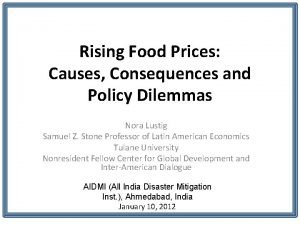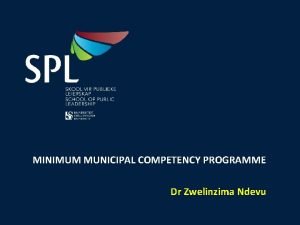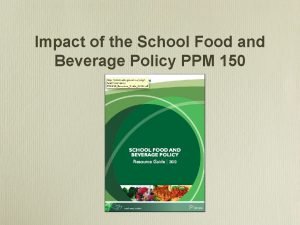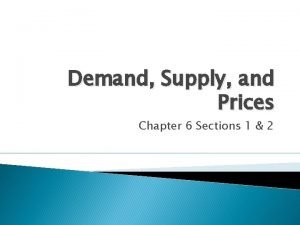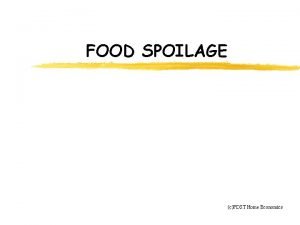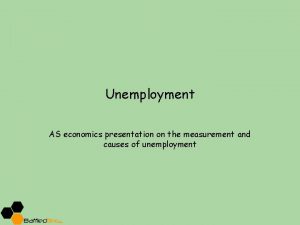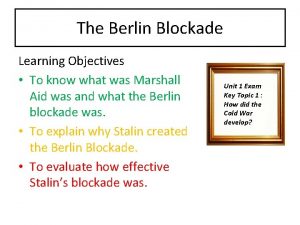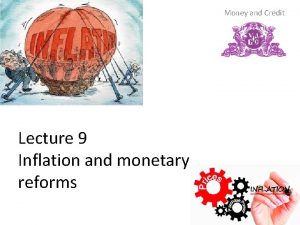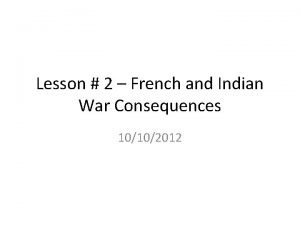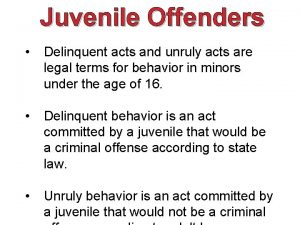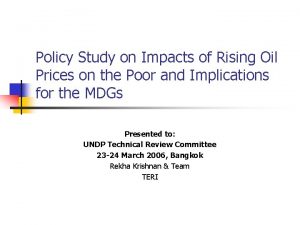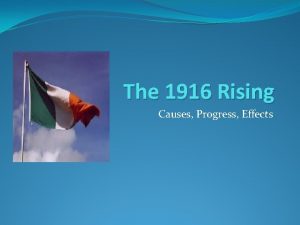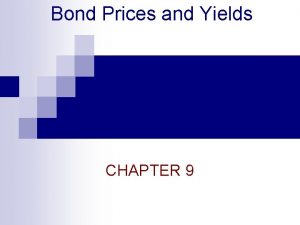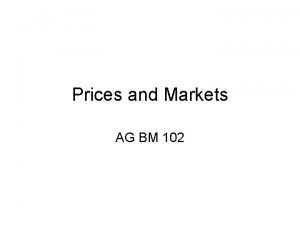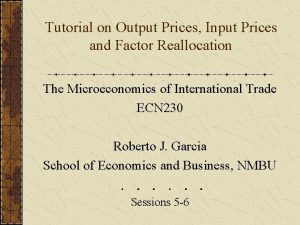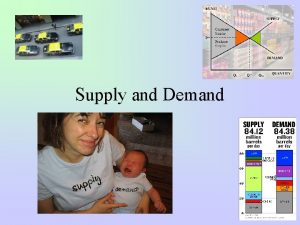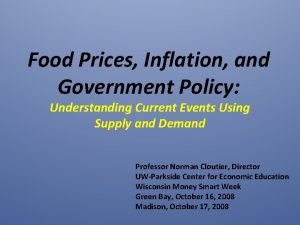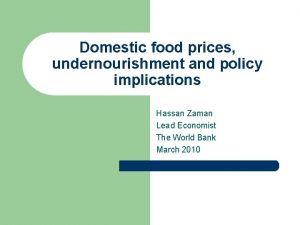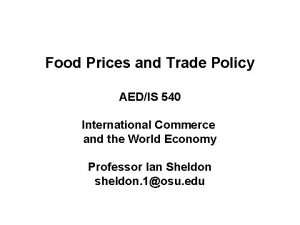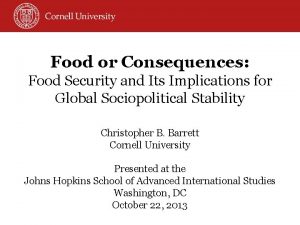Rising Food Prices Causes Consequences and Policy Dilemmas












































- Slides: 44

Rising Food Prices: Causes, Consequences and Policy Dilemmas Nora Lustig Samuel Z. Stone Professor of Latin American Economics Tulane University Nonresident Fellow Center for Global Development and Inter-American Dialogue AIDMI (All India Disaster Mitigation Inst. ), Ahmedabad, India January 10, 2012

“The world food system today is far too complex for common sense to understand. “ Ela R. Bhatt Food Must Not be Reduced to Security, December 2011

Food is special… • Most basic of basic needs; for the poor, food has no substitutes; energy for human survival • There are both net food producers and net food consumers among the poor And, with biofuels, • Food commodities have turned into industrial commodities; energy for machines

“Voices of the Poor” and Food Deprivation (WDR, Attacking Poverty, 2000/1) • Your hunger is never satiated, your thirst is never quenched; you can never sleep until you are no longer tired. —Senegal 1995 • It’s the cost of living, low salaries, and lack of jobs. And it’s also not having medicine, food and clothes. —Brazil 1995 • When I leave for school in the mornings I don’t have any breakfast. At noon there is no lunch, in the evening I get a little supper, and that is not enough. …. I think I’m going to die of hunger. —A 10 -year-old child, Gabon 1997 • Often she has to decide who will eat, she or her son. —Ukraine 1996 • In the evenings, eat sweet potatoes, sleep. In the mornings, eat sweet potatoes, work. At lunch, go without. – Vietnam, 1999

Rising Food Prices • Causes: what do think we know? What do we need to know? Will we ever know? • Consequences: does the debate of whether the poor benefit or get hurt from higher food prices really matter? • Policy responses: – Macro policies and market-specific interventions to insulate domestic prices – Safety nets




Experts were expecting prices to rise, but not at the observed pace… WDR (2008) • Although standard models predicted that food prices would rise due to supply-side constraints, the orders of magnitude bear no resemblance with what happened to food prices in the past few years. • The models predicted that cereal prices would rise at 0. 26 percent a year to 2030 and 0. 82 percent a year from 2030 to 2050. • In contrast, from January 2002 to June 2008, the price index of internationally traded food commodities prices increased by 130 percent, or about 20 percent per year or 100 times more than the predictions (!).

Volatility has become very difficult to predict… IMF (WEO, 2011): • Food prices are 80 percent higher than they were in 2000. • In 2000, food prices were at their lowest in decades. • Volatility high, which makes it hard to predict.


Searching for a cause • From commodity-specific framework to aggregate factors: – the “China/India- effect”-- no evidence of surge in demand; demand for food consumption and supply rose at the same pace (1. 7%/yr) – dollar depreciation-- prices rose in all major currencies – higher energy costs – could account for less than 20 percent

Commodity Prices in Major Currencies, January 2000 -June 2008 (cont. ) Non-Fuel Commodity Price Index (January 2000=100) Source: Author’s construction with data from IFS, IMF for prices and OECD Stat for exchange rates. cont.

Searching for a cause • From commodity-specific framework to aggregate factors: – developing countries response; defensive and do not seem to be a general cause (rice might be the exception) – biofuels – monetary easing in US

Export Restrictions and the Price of Rice, June 2007 -July 2008 Source: IMF Primary Commodity Prices Database. Export policies from Slayton and Timmer (2008). Based on a graph by Slayton and Timmer (2008).

Two Major Drivers • Biofuels: structural shift in demand since 2004; for maize, it grew at around 40 percent a year and accounted for 70 -80 percent of increase in demand • Macroeconomic Factors: monetary easing => inflationary expectations, depreciation of dollar and assets (Great Recession) and securitization of food commodities (price increase acceleration 2007 -2008)

Surge in demand for industrial (biofuels) use of corn and oilseeds • Between 2004 and 2007 – Feed use of corn grew by 1. 5 percent a year and food use of oilseeds grew by 3 percent a year – Industrial use grew by 36 percent and 11 percent, respectively =>Demand for corn- and oilseeds-based biofuels is a major driver of food commodities price increases. =>Estimates range from a third to 60 percent (Collins, 2008; Mitchell, 2008; Rosegrant, 2008). 17

Corn and Soybeans prices and U. S. Ethanol Production, 1995 -2007 (Elliott, 2008) Source: Author's construction based on IMF Primary Commodity Database and Renewable Fuels Association. Notes: Ethanol production is for the United States. Prices refer to Maize (corn), U. S. No. 2 Yellow, FOB Gulf of Mexico, U. S. price (average of daily quotations); Soybeans, U. S. soybeans, Chicago Soybean futures contract (first contract forward) No. 2 yellow and par (average of daily quotations).

Biofuels • “Discovery” of biofuels – => converted food crops into cash crops on a large scale; structural shift – => from an income elasticity below unity to one above unity; if energy prices remain high, demand pressure for raw materials used in biofuels will remain high – =>existing estimates from 30 to 60% of the increase in food commodities prices due to biofuels – => higher oil prices get transmitted to food commodities not because of higher costs (small contribution) but because now food crops and oil are “substitutes”

Implications • The surge in demand for food commodities for industrial purposes (biofuels) represents a structural break with the past. • Food commodities prices will be: – Secularly higher (income elasticity for energy is around one while for food is below one): level effect. – More sensitive to the same forces that affect the prices of nonrenewable energy sources such as oil: increased volatility. • In contrast to the past, demand for food commodities will fluctuate with the business cycle and be affected by policy-related supply shocks in the oil market. 20

What is at Stake? • Because of biofuels, the relative price of food may stay much higher and for much longer than it was anticipated – =>negative effects on poverty reduction in the developing world – =>negative effects on economic growth in poorest countries (Fogel in reverse) • A rules-based trading system is more at risk than before – =>negative effects on global welfare from “beggar-thyneighbor” policies

Policy response in developing countries may exacerbate pressure on international prices • Developing countries will continue to go their own way (restricting exports, subsidizing home production) because biofuels subsidies create a huge negative externality on food prices • How and on what grounds can this tendency be stopped? Moral imperative is low; leverage is low

Macroeconomic Factors: Monetary Easing in the US • Curious fact: Since mid-2007 to mid-2008 commodity price rises accelerated while the global economy started to slow-down: – =>for food commodities a third of the increase occurred in 15 percent of the time. • Explanation: as US Fed started to lower interest rates in the wake of subprime crisis, investors shifted resources away from dollar instruments into everything else: foreign currencies, foreign stocks and commodities. – => foreign currencies appreciated, foreign stock markets boomed and commodity prices soared. 23

Real Interest Rate and Commodity Prices, January 2007 -August 2008 Source: Author’s construction with data from the IMF Primary Commodity Database, IMF International Financial Statistics and Federal Reserve Bank of Cleveland. Notes: Real interest rate is the Federal Funds Rate adjusted for expected inflation.

• Unclear whether this process was driven by: – Inflationary expectations. (Frankel, 2008; Calvo, 2008) – Expectations based on what in retrospect were misperceptions about global economy (i. e. , belief in “decoupling”). – Price bubble. • This process came to a halt with the realization that crisis was global and the dollar became a safe-haven in the wake of Lehman’s collapse. 25

The Main Drivers of Rising Food Commodities Prices: A Summary of the Literature

Impact of rising food prices on poverty • An “old” debate: are higher food prices good or bad for the poor? • Answer: both – Net sellers (rural poor with land agricultural workers) benefit. – Net buyers (landless peasants and urban poor) get hurt. • Majority of studies show that those who get hurt outnumber those who benefit: – Headcount ratio higher. – Severity of poverty (the squared poverty gap) higher. [for example, Ackah and Appleton (2007); Barrett and Dorosh (1996); Deaton (1989); Lustig (1986); Mellor (1978); Pinstrup-Andersen (1987); Ravallion and van de Walle 27 (1991); Ravallion (1990); Trairatvorakul (1984)]

Impact of rising food prices on poverty: empirical analysis of recent food prices rise =>in spite of all the differences in methodology and assumptions, studies suggest that in the majority of countries, higher food commodities prices increase poverty –at least in the short-run--. =>although poverty increases considerably more in urban areas, in many instances rural poverty goes up as well. => in some countries, however, the net effect on poverty is positive (i. e. , poverty falls). 28

Percentage points change in poverty rates from 2005 -7 price changes Source: Ivanic and Martin (2008) 29

Impact of rising food prices on poverty • Some poor benefit (net producers and agricultural workers) and some poor lose (net consumers) as a result of higher food prices • Even if aggregate poverty measures show a decline (most don’t), shouldn’t we protect the extreme poor from becoming poorer as a result of higher food prices?

Poverty Impacts of Recent Increases in Food Prices: A Summary of Available Studies

Poverty Impacts of Recent Increases in Food Prices: A Summary of Available Studies (cont. )

Impact of rising food prices on poverty: empirical analysis • Ivanic and Martin (2008 a) show that about 105 million people in the least developed countries have been added to the world’s poor since 2005 because of rising food prices. This is equivalent to about 10 percent of the people living on less than a dollar a day and, according to the authors, equivalent to approximately seven lost years of progress in poverty reduction. • Robles et al. ( 2008) estimate that for LAC the increase in world food prices between January 2006 and March 2008 resulted in an increase of 4. 3 percentage points in the headcount ratio or 21 million additional poor individuals. • CEPAL (2008)—the UN Economic Commission for Latin America and the Caribbean-- estimates that the ranks of the extremely poor and the moderately poor increased by 10 million each. 33

Impact of rising food prices on poverty: empirical analysis • Asian Development Bank (2008) suggests that a 20% increase in food prices would raise the number of poor individuals by 5. 65 and 14. 67 million in Philippines and Pakistan, respectively. • Wodon et al. (2008) estimate that a 50% increase in food prices leads to an average increase of the headcount ratio of 4. 4 percent. pts. In Sub-Saharan African countries (2. 5 if producers are included) • Haq et al. (2008) found that food price increases in Pakistan might have increased urban poverty by 44. 6 percent and rural poverty by 32. 5 percent. • Valero-Gil and Valero (2008) find that moderate consumption poverty increased from 25 to 33. 5 percent and extreme poverty from 10. 58 to 15. 95 percent with the spike in food prices during 2008 even after taking into account the positive effects of reduced taxes and tariffs and higher cash transfers to the poor. • Warr (2008) finds that higher food prices, especially staple grains, worsen poverty incidence in Thailand despite the presence of large numbers of poor farmers, many of whom benefit from higher prices. 34



Standard policy recommendations • To contain inflationary pressures: – If country has large international reserves, currency can be appreciated (e. g. , Central Bank sells dollars). – If reserves are not large or if exchange rate appreciation has already been too large, tighten fiscal policies • To mitigate the impact on the poor: – Use targeted safety nets (cash transfers, food stamps, school feeding programs, food-for-work, food distribution programs) 37

Policy dilemmas are significant • An appreciation of the local currency creates disincentives to exporters and hurts importcompeting sectors and, in more extreme cases, it can slow down growth. • Tight monetary (i. e. , raising domestic interest rates) and fiscal (i. e. , cutting down on expenditures) policies have a dampening effect on economic activity. 38

In addition, existing safety net system inadequate • Safety net programs are often nonexistent or small (about half of developing countries do not have safety net programs) • Safety nets often not designed to respond to shocks (no “insurance component”): – Do not increase the size of the transfer automatically when a shock (such as food price increases) occurs. – Do not expand the number of beneficiaries to include those who become poor as a result of the shock. 39

Should targeted interventions be shunned? • Most countries respond by “intervening” in the specific markets • Reducing taxes and tariffs on food, price controls, price subsidies, export taxes, export bans, etc.

Targeted Measures to Contain Price Increases: 2007/8 episode Source: Author’s construction with information from the World Bank (2008 d) and expanded with Trostle (2008), ADB (2008) and World Bank (2008 e).

Policy response exacerbated upward pressure on prices • Ivanic, Martin, Mattoo and Subramanian (2008) show that if developing countries try to offset a fifty percent increase in the world prices of rice, corn, wheat and soybeans applying policy responses aimed at restoring individual countries' domestic prices, world market prices will rise by 10 to 30 percentage points. • But, developing countries are likely to succeed in not only lowering their market prices by a few percentage points but also in lowering their market price volatility. • Safety nets to the poor may not avoid the former. • Are there some interventions less damaging than others? 42

Sources Lustig, N. “Thought for Food: the Challenges of Coping with Soaring Food Prices, ” Working Paper No. 155, Center for Global Development, Washington, D. C. , November 2008. http: //www. cgdev. org/content/publications/detail/967250 • Lustig, N. “Coping with Rising Food Prices: Policy Dilemmas in the Developing World, ” Working Paper No. 164, Center for Global Development, March 2009 and Tulane Economics Department Working Paper 0907, May 2009. http: //www. cgdev. org/content/publications/detail/1421334 and http: //ideas. repec. org/p/tul/wpaper/0907. html • • Lustig, N. “The Curse of Volatile Food Prices: Policy Dilemmas in the Developing World, ” in Natural Resources and Development, Mavrotas, George, editor, Edward Elgar Publishers, Cheltenham: UK, forthcoming.

Thank you! Nora Lustig nlustig@tulane. edu
 Rising food prices causes and consequences
Rising food prices causes and consequences False dilemma in the crucible
False dilemma in the crucible School social work ethical dilemmas
School social work ethical dilemmas What is an ethical dilemma? *
What is an ethical dilemma? * 5 steps in resolving ethical dilemmas
5 steps in resolving ethical dilemmas Ethical dilemmas in engineering
Ethical dilemmas in engineering Ethical reasoning
Ethical reasoning Cpa ethical dilemmas
Cpa ethical dilemmas Ethical dilemmas in history
Ethical dilemmas in history Ethical dilemmas in early childhood education
Ethical dilemmas in early childhood education Leadership dilemmas grid solutions
Leadership dilemmas grid solutions Ultimate cause of behavior
Ultimate cause of behavior Proximate behaviour in animals
Proximate behaviour in animals Unit 2 food food food
Unit 2 food food food Food chain food chain food chain
Food chain food chain food chain How to draw esperanza rising
How to draw esperanza rising Things fall apart epigraph
Things fall apart epigraph Choices and consequences examples
Choices and consequences examples Allen steble
Allen steble Olavi voittonen
Olavi voittonen 5 unsafe attitudes and consequences
5 unsafe attitudes and consequences Choices have consequences philosophy
Choices have consequences philosophy Actions and their consequences examples
Actions and their consequences examples Important things that happened in act 4 of romeo and juliet
Important things that happened in act 4 of romeo and juliet Cause and effect examples
Cause and effect examples Www.feedbackrewards.com today
Www.feedbackrewards.com today School food and beverage policy
School food and beverage policy Chapter 6 prices and decision making assessment answers
Chapter 6 prices and decision making assessment answers Tripod pricing strategy
Tripod pricing strategy Chapter 6 demand supply and prices
Chapter 6 demand supply and prices Jose agramonte
Jose agramonte Causes of food spoilage
Causes of food spoilage Unintended consequences
Unintended consequences Unemployment consequences
Unemployment consequences Blue earth county attorney
Blue earth county attorney Teenage alcohol consumption
Teenage alcohol consumption Berlin blockade summary
Berlin blockade summary What are the consequences of sin in genesis chapter 3
What are the consequences of sin in genesis chapter 3 Consequences of ww1
Consequences of ww1 Air pollution consequences
Air pollution consequences Consequences of inflation
Consequences of inflation Consequences
Consequences Consequences of unruly behavior
Consequences of unruly behavior Demand-pull inflation occurs when
Demand-pull inflation occurs when Manners definition
Manners definition
